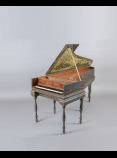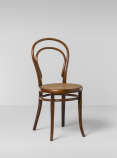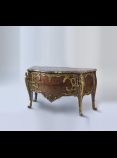Wood, design and sustainability

Harpsichord, c. 1737. Christian Zell, Hamburg. Boxwood, ebony, red pine and maple. Museu de la Música de Barcelona

No. 414 Chair. c. 1890. Gebrüder Thonet. Steamed beech, solid cane wickerwork and iron. Production: Gebrüder Thonet, Vienna. Donation: Espai Corbat, 2018. MDB 3.076

Chest of drawers, 1875–1900. Maison Millet. Oak, rosewood, bois satinée, bronze and Breche Violette marble. Production: Maison Millet, Paris (1853–1918) MDB 648
The second area focuses on wood as the great ally of humanity throughout history. It accordingly displays several wood-based man-made materials, from the Palaeolithic period to the present day, with an emphasis on artefacts or designs that, over the course of history, have represented a turning point in the cultural evolution of human life, with regard to both the natural environment and social milieu. From the Shöningen spears, today's oldest-known wooden artefacts, created by humans some 400,000 years ago, and the ladle, a design of global reach, cultural diversity and wood biodiversity that has stood the test of time, to the steam-curved wood procedure that led to the democratisation of furniture in the second half of the 19th century, by enabling its mass production, storage, assembly and spread throughout Europe.


